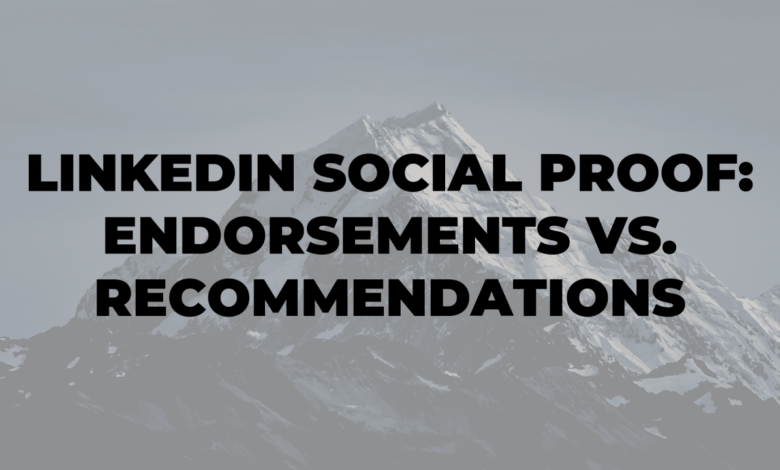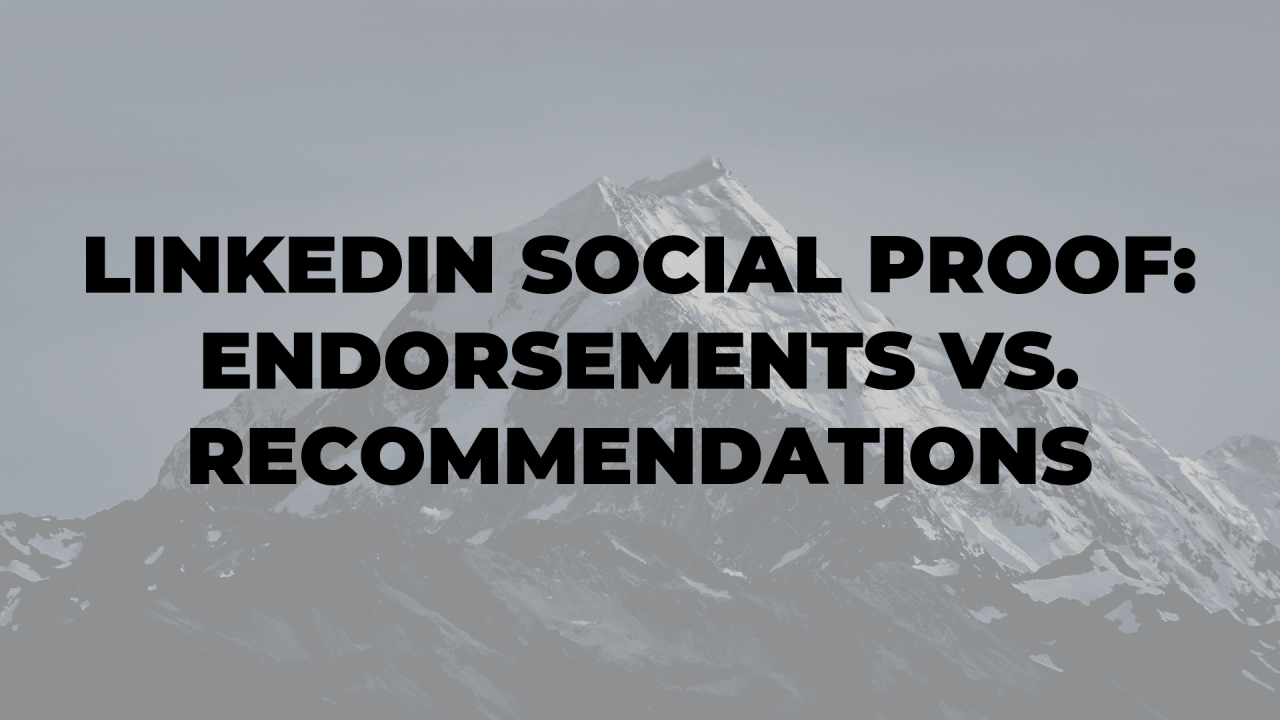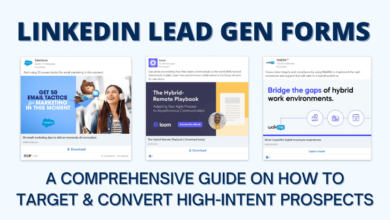
LinkedIn Endorsements and Recommendations Build Credibility
LinkedIn endorsements and recommendations build credibility, providing a powerful way to showcase expertise and skills. This in-depth look explores how to leverage these valuable tools to enhance your professional profile and career advancement. We’ll delve into understanding endorsements and recommendations, building credibility through them, their impact on your career, and managing your profile effectively.
From understanding the subtle differences between endorsements and recommendations, to navigating the process of requesting and responding to them, this guide will equip you with practical strategies to maximize their impact. We’ll also discuss the importance of authenticity and reciprocity within your professional network.
Understanding Endorsements and Recommendations
LinkedIn endorsements and recommendations are powerful tools for building credibility and showcasing expertise within a professional network. They go beyond simple connections and offer a way to validate skills and experience, enhancing your profile and career prospects. These tools are increasingly important in a competitive job market, helping to differentiate individuals and demonstrate their capabilities in a clear and impactful manner.Endorsements and recommendations act as social proof, providing tangible evidence of your skills and abilities.
LinkedIn endorsements and recommendations are crucial for building credibility. They showcase your expertise and trustworthiness, much like a stellar online presence. To further amplify your professional image, consider creating a top-notch Facebook business page; how to create the perfect Facebook business page is a great starting point. A polished Facebook presence, combined with strong LinkedIn endorsements, will truly solidify your professional standing.
They not only increase your visibility but also contribute to a stronger professional reputation, making you a more attractive candidate for opportunities. This is especially true in fields where technical skills are highly valued.
LinkedIn Endorsements
LinkedIn endorsements are public affirmations of a user’s skills. They are essentially “thumbs up” votes that signify a connection’s recognition of your proficiency in a particular area. Endorsements are visible to all connections, which is one of their key advantages. They provide a way to showcase your abilities and expertise in a quick and accessible format.
LinkedIn Recommendations
Recommendations, on the other hand, are more detailed and substantial than endorsements. They provide a deeper insight into your abilities, experience, and personality, going beyond simple skill recognition. Recommendations are typically more in-depth, highlighting specific examples of your work and impact on projects.
Types of Endorsements and Recommendations
Endorsements and recommendations can cover a broad spectrum of skills and experiences. These are not limited to specific professions or fields. The types can be categorized based on the context and recipient. For instance, a recommendation for a software developer might focus on coding skills, project management, and problem-solving abilities.
- Technical Skills: Endorsements and recommendations in technical fields like software development, data analysis, or cybersecurity are crucial for demonstrating expertise in specific technologies and methodologies.
- Soft Skills: Soft skills, such as communication, teamwork, and leadership, are also valuable to endorse and recommend. These endorsements can highlight a candidate’s interpersonal abilities and their capacity to work effectively in teams.
- Professional Experience: Recommendations can also showcase your experience in specific roles or industries. They often highlight quantifiable achievements and contributions, providing a more comprehensive picture of your capabilities.
Obtaining Endorsements and Recommendations
The process for obtaining endorsements and recommendations on LinkedIn is straightforward. To receive an endorsement, simply ask your connections to endorse your skills. For recommendations, it’s best to initiate the request, clearly outlining the specific areas you’d like the recommendation to cover.
- Identify relevant connections: Choose connections who have worked with you on projects or have observed your work in specific roles.
- Reach out politely: Clearly communicate your request for an endorsement or recommendation, specifying the skills or aspects of your work you want to highlight.
- Provide context: Provide context to your request by briefly mentioning relevant projects or experiences.
Endorsements vs. Recommendations
The following table summarizes the key differences between endorsements and recommendations, highlighting their respective value and impact on credibility.
| Feature | Endorsement | Recommendation |
|---|---|---|
| Format | Simple “thumbs up” for skills | Detailed description of abilities and accomplishments |
| Length | Short | Longer, narrative format |
| Visibility | Public | Public (optional to make private) |
| Credibility Impact | Demonstrates proficiency in specific skills | Provides evidence of skills in action and impact |
Building Credibility with Endorsements
LinkedIn endorsements and recommendations can significantly boost your professional credibility. They provide social proof, validating your skills and expertise in the eyes of potential employers, collaborators, and clients. A well-managed endorsement strategy can position you as a trusted and competent professional, opening doors to new opportunities.Positive endorsements and recommendations are powerful testimonials. They act as a third-party validation of your capabilities, lending a level of trust and reliability that individual self-promotion often lacks.
This social validation can be crucial in a competitive job market, where standing out from the crowd is essential.
Key Elements Contributing to Credibility
Endorsements and recommendations build credibility when they are genuine, specific, and relevant. Vague or generic endorsements lack impact and can even undermine your reputation if perceived as inauthentic. Instead, specific examples of how you’ve applied your skills are invaluable. For example, an endorsement stating “Excellent communicator, consistently delivered clear and concise presentations” is more impactful than a simple “Excellent communicator.” The former illustrates a tangible skill application.
Impact of Positive Endorsements and Recommendations
Positive endorsements and recommendations have a substantial impact on professional reputation. They showcase your strengths, highlight your accomplishments, and demonstrate your ability to deliver results. This positive feedback loop can lead to increased visibility, greater opportunities, and higher earning potential. Potential employers, collaborators, and clients often view endorsements and recommendations as a reliable indicator of a professional’s competence and reliability.
They provide a snapshot of how you perform in a professional setting.
Authenticity and Genuineness
Authenticity and genuineness are paramount in endorsements and recommendations. A recommendation that echoes the words and tone of the recommender, while still focusing on your positive traits, demonstrates credibility. Avoid overly embellished or exaggerated statements. Focus on the real value you bring to a situation, demonstrating genuine abilities. Fabricated or exaggerated endorsements can quickly damage your professional reputation.
Leveraging Endorsements to Showcase Expertise
Endorsements and recommendations are a powerful tool to showcase your expertise and skills. Select endorsements that directly reflect your key skills and experience. If you are a project manager, endorsements focusing on project management abilities would be beneficial. Don’t just focus on general praise, highlight the specifics of your accomplishments. A good example is an endorsement that mentions your leadership in successfully completing a project on time and within budget.
LinkedIn endorsements and recommendations are a fantastic way to build credibility. They showcase your skills and experience, making you stand out from the crowd. For event planners, leveraging the right social media management companies, like the ones listed on this helpful resource best social media management companies for event planners , can help you amplify your online presence and build a strong reputation.
This, in turn, can lead to more clients and boost your overall credibility on LinkedIn.
Strategic Utilization for Career Advancement
Strategic use of endorsements can significantly enhance your professional profile and career advancement. A well-curated profile showcasing relevant endorsements creates a compelling narrative of your capabilities. Endorsements help to build a stronger online presence and allow you to highlight your expertise in a clear and concise way. This enhanced profile can attract the attention of recruiters, employers, and collaborators.
Best Practices for Requesting and Responding
| Action | Best Practice |
|---|---|
| Requesting Endorsements | Be specific in your requests. Focus on endorsements that highlight your specific skills and expertise. Actively seek recommendations from people who have worked with you. |
| Responding to Endorsements | Respond to endorsements with a sincere thank you. This simple gesture acknowledges the endorsement and fosters positive relationships. Consider responding to endorsements from your peers as well. |
| Requesting Recommendations | Be proactive in requesting recommendations from individuals who have worked closely with you. Clearly articulate why a recommendation would be beneficial. |
| Responding to Recommendations | Express gratitude for the recommendation. Actively engage in conversations with recommenders. Maintain open communication and nurture professional relationships. |
Impact on Career and Opportunities
Endorsements and recommendations on LinkedIn are powerful tools for boosting your career prospects. They act as social proof, showcasing your skills and experience to a wider network and potential employers. By demonstrating expertise and positive feedback from peers and colleagues, you can significantly enhance your professional credibility and unlock new opportunities.Beyond just listing accomplishments, endorsements and recommendations provide a personalized perspective on your abilities.
They paint a richer picture of your work ethic, communication skills, and overall professional value, making you a more compelling candidate for any role.
Positive Influence on Job Opportunities
Endorsements and recommendations are increasingly important for securing job interviews and offers. A strong profile, replete with positive feedback, demonstrates a candidate’s value and competence. Potential employers and recruiters often filter through profiles, looking for verified expertise and positive testimonials. Endorsements from industry leaders or former supervisors can significantly sway hiring decisions in favor of a candidate.
Attracting Potential Employers and Recruiters
A robust endorsement and recommendation profile can significantly increase a candidate’s visibility to recruiters and potential employers. The validation provided by others is often more convincing than self-promotion. Recruiters actively search for profiles with consistent positive feedback, highlighting relevant skills and expertise. This targeted approach saves recruiters time and effort, allowing them to focus on the most promising candidates.
Networking Opportunities and Career Growth
A strong endorsement and recommendation profile naturally attracts valuable networking opportunities. Individuals with positive feedback are often approached for collaborations, mentorship, or joint projects. This expanded network can lead to new opportunities, insights, and career advancement. Recommendations from established professionals can open doors to opportunities previously inaccessible.
Real-Life Case Studies
Several professionals have leveraged endorsements and recommendations to advance their careers. For example, a software engineer with strong endorsements in coding and problem-solving was quickly recruited by a top tech firm. Their recommendations from previous employers highlighted their ability to lead projects and deliver high-quality results. Another example includes a consultant who secured several high-profile consulting gigs through recommendations from satisfied clients.
Their positive testimonials showcased their expertise and reliability.
Benefits for Professional Services and Consulting
Recommendations are crucial for building credibility in professional services, consulting, or freelancing. A profile with testimonials from past clients or collaborators demonstrates expertise, reliability, and the ability to deliver desired results. This builds trust and encourages further engagement. Clients are more likely to hire or engage professionals with demonstrably positive experiences.
Career Path Support
| Career Path | How Endorsements and Recommendations Support |
|---|---|
| Software Engineer | Endorsements in coding, problem-solving, and project management highlight specific skills and competencies. |
| Consultant | Testimonials from satisfied clients build trust and showcase the ability to deliver desired outcomes. |
| Project Manager | Recommendations demonstrating leadership, organization, and successful project completion strengthen the profile. |
| Freelancer | Endorsements showcase expertise in a specific area, attracting clients and demonstrating value. |
| Marketing Professional | Recommendations from satisfied clients highlight skills in strategy, campaign execution, and results. |
Managing and Maintaining a Strong Profile
A strong LinkedIn profile isn’t just about initial creation; it’s a continuous effort requiring proactive management. Maintaining a positive and credible image through endorsements and recommendations is crucial for career advancement and opportunity creation. This proactive approach demonstrates your commitment to professional development and enhances your reputation within your network.Regular review and careful consideration of your endorsements and recommendations are vital.
A well-maintained profile showcases your expertise and value to potential employers, recruiters, and collaborators.
Strategies for Maintaining a Strong Profile
Maintaining a positive and professional image on LinkedIn requires a proactive approach. Regularly reviewing your endorsements and recommendations ensures they continue to accurately reflect your skills and experience. This proactive approach ensures your profile remains a strong representation of your capabilities.
Managing Endorsements and Recommendations
Regularly reviewing your endorsements and recommendations is key to preventing potential negative impacts on your credibility. This involves identifying endorsements that may not accurately reflect your skills or those that are outdated.
LinkedIn endorsements and recommendations are super helpful for boosting your professional credibility. Knowing how to effectively manage your online presence, like a YouTube channel, is also key. Check out these 7 tips tricks on how to manage a YouTube channel for some helpful strategies here. Ultimately, a strong online profile, including LinkedIn, will show potential employers and collaborators your skills and experience, which is where those endorsements and recommendations come into play again.
Handling Negative or Outdated Endorsements
If you encounter endorsements that are inaccurate or outdated, address them promptly. You can politely decline or remove endorsements that do not accurately reflect your current skills. It’s important to handle these situations professionally, demonstrating respect for your network while maintaining accuracy. For example, if an endorsement for a skill you no longer use frequently is present, you can politely decline it.
Importance of Timely Responses to Endorsement Requests
Responding promptly to endorsement requests demonstrates professionalism and strengthens relationships within your network. It also showcases your willingness to engage with your connections and acknowledge their contributions. A timely response shows respect and appreciation for the gesture.
Soliciting and Obtaining Relevant Endorsements and Recommendations
Actively seeking endorsements and recommendations is a proactive way to build credibility. Identify individuals who have witnessed your skills and contributions and request endorsements or recommendations. These should be tailored to specific skills and accomplishments. Reaching out to past colleagues, mentors, or clients who can vouch for your work is a crucial step in proactively building your professional reputation.
Plan for Actively Soliciting Endorsements and Recommendations
Create a plan to proactively request endorsements and recommendations. Identify individuals who have worked with you, observed your skills, or witnessed your contributions. This proactive approach allows you to curate a strong endorsement profile. Reach out to these individuals directly, expressing your appreciation for their past collaborations and requesting endorsements for specific skills.
Dos and Don’ts for Using Endorsements and Recommendations
A well-managed profile showcases a professional and credible image.
- Do: Regularly review your endorsements and recommendations to ensure accuracy and relevance.
- Do: Respond promptly to endorsement requests.
- Do: Actively solicit endorsements and recommendations from individuals who have observed your skills.
- Do: Ensure endorsements are for skills you currently possess.
- Don’t: Accept endorsements for skills you don’t possess or have not used.
- Don’t: Request endorsements from individuals you haven’t worked with closely.
- Don’t: Solicit endorsements in a way that seems desperate or intrusive.
- Don’t: Accept endorsements for skills that are significantly outdated.
Requesting Endorsements and Recommendations Professionally
Requesting endorsements and recommendations should be done in a professional and courteous manner. A personalized approach, highlighting specific contributions and skills, increases the likelihood of receiving positive endorsements. Avoid generic requests and focus on the value you provided to the individual. A polite and appreciative request demonstrates respect and professionalism.
- Example: “Hi [Name], I hope this email finds you well. I was reflecting on our recent collaboration on the [project name] project, and I wanted to express my appreciation for your support. I particularly valued your expertise in [specific skill]. Would you be open to endorsing my skills in [specific skill] on LinkedIn? Your endorsement would be greatly appreciated.”
Engaging with the Community and Network
LinkedIn endorsements and recommendations are more than just digital accolades; they’re powerful tools for building genuine connections and expanding your professional network. Actively engaging with the community using these tools allows you to demonstrate your expertise, foster trust, and open doors to new opportunities. Leveraging endorsements and recommendations strategically can transform your LinkedIn profile from a static resume to a dynamic hub for professional interaction.
Using Endorsements to Engage
Endorsements, when strategically employed, can significantly boost your visibility within the LinkedIn community. By endorsing others, you demonstrate your appreciation for their skills and contributions. This reciprocal action fosters a sense of community and strengthens professional relationships. This, in turn, can attract endorsements from others, which further elevates your profile and positions you as a knowledgeable and reliable professional.
Fostering Professional Relationships
Endorsements and recommendations can be powerful catalysts for building professional relationships. When you recommend someone, you’re not just highlighting their skills; you’re vouching for their character and professionalism. This act of recommendation demonstrates your willingness to support others, and in return, creates a positive impression on the recipient and other members of your network. This creates a reciprocal exchange of trust and respect that can lead to future collaborations and opportunities.
Facilitating Networking and Knowledge Sharing
Endorsements and recommendations are effective tools for networking and knowledge sharing. By endorsing colleagues for specific skills, you create a dialogue about their expertise and open the door for further connections. Recommending someone for a specific role or opportunity not only supports their career advancement but also showcases your understanding of their strengths and capabilities. This, in turn, fosters a sense of community and allows professionals to share knowledge, experience, and insights.
Reciprocity and Mutual Endorsement
Reciprocity is crucial in building a strong professional network on LinkedIn. Mutually endorsing each other for skills demonstrates a commitment to professional growth and collaboration. This reciprocity fosters trust and strengthens bonds within your network, leading to a more supportive and collaborative environment. For instance, if you’re a marketing specialist and you endorse a colleague for their exceptional communication skills, they might reciprocate by endorsing you for your marketing expertise.
This creates a win-win scenario where everyone benefits.
Effective Methods for Building a Strong Network
| Method | Description |
|---|---|
| Mutual Endorsements | Actively endorse colleagues for skills they excel in, expecting reciprocity. |
| Targeted Recommendations | Write specific and detailed recommendations highlighting the recipient’s contributions and skills, focusing on impact. |
| Engaging in Group Discussions | Actively participate in relevant LinkedIn groups, sharing your expertise and insights through thoughtful comments. |
| Following and Connecting with Influencers | Follow industry leaders and experts, engaging with their posts and connecting with those who align with your interests. |
| Sharing Valuable Content | Share insightful articles, industry news, and personal experiences to contribute to the knowledge-sharing within your network. |
Staying Connected Through Endorsements and Recommendations
Regular engagement with endorsements and recommendations keeps your network active and engaged. It’s a continuous process of showing appreciation, supporting colleagues, and strengthening professional relationships. This consistent effort fosters a sense of community and mutual support, paving the way for future collaborations and career advancement. Remember, building a strong network is an ongoing process that requires consistent effort and genuine engagement.
Addressing Potential Challenges: Linkedin Endorsements And Recommendations Build Credibility

Navigating endorsements and recommendations on LinkedIn can sometimes feel tricky. While these tools are powerful for building credibility, there are potential hurdles to overcome. Understanding these challenges and having strategies to address them is key to maximizing the benefits of this feature.
Identifying Potential Challenges
Successfully leveraging LinkedIn endorsements and recommendations requires proactive engagement and a nuanced understanding of your network. Potential obstacles often arise from a lack of awareness or proactive management. Misunderstandings about the purpose and impact of endorsements and recommendations can lead to suboptimal results. Also, unexpected or negative feedback can impact your profile perception.
Solutions to Common Challenges, Linkedin endorsements and recommendations build credibility
Effective strategies can mitigate common challenges. These solutions focus on building genuine connections, understanding the context, and proactively managing requests.
- Understanding Your Network: Thoroughly assessing your network is crucial. Consider the relationships you have and the type of endorsement each person can offer. A recommendation from a former colleague in a similar field holds more weight than a recommendation from someone you barely know.
- Proactive Management of Requests: Don’t hesitate to decline requests for endorsements or recommendations if you feel they are inappropriate or don’t accurately reflect your skills or experience. Open communication with your network about the endorsements you are comfortable with will help to avoid any confusion.
- Addressing Negative or Irrelevant Endorsements: A negative or irrelevant endorsement can harm your profile’s overall impression. Responding thoughtfully and professionally is key. A simple, polite explanation that the endorsement is not reflective of your current capabilities can neutralize the negative impact.
Responding to Negative or Irrelevant Endorsements
Addressing negative or irrelevant endorsements requires a measured response. Avoid aggressive or defensive language. Focus on maintaining a professional demeanor and clarifying the context of the endorsement.
- Clarification: A clear and concise explanation of the context of the endorsement is important. For instance, if the endorsement refers to a skill you no longer use, you can politely explain the change in your professional focus.
- Professionalism: Maintaining a professional tone is critical. Avoid making the situation personal or escalating the interaction.
- Time Sensitivity: Addressing negative endorsements promptly can minimize potential damage to your reputation.
Managing Requests for Endorsements You May Not Be Comfortable With
It’s important to have a strategy for managing requests for endorsements you may not be comfortable with. Declining these requests gracefully and respectfully is essential.
- Professional Declination: Craft a polite and professional response that explains your reason for declining the request without being rude. For example, “Thank you for considering me for an endorsement. I appreciate your recommendation, but I don’t feel comfortable with an endorsement on [specific skill] at this time.”
- Alternative Suggestion: If possible, suggest an alternative approach that might be more appropriate, such as a recommendation instead of an endorsement.
- Open Communication: Openly communicating with your network about your professional goals and current expertise can prevent misunderstandings and unnecessary requests.
Importance of Understanding Your Network and Context of Endorsements
A crucial aspect of managing endorsements is understanding the context and the people involved in your network.
- Relationship Dynamics: Endorsements from trusted colleagues or supervisors in relevant fields hold more weight than those from individuals you have a less established relationship with.
- Endorsement Relevance: Ensure endorsements accurately reflect your current skills and capabilities. An endorsement for a skill you no longer use is less valuable.
Example Scenarios and Solutions
The table below illustrates various scenarios related to endorsements and recommendations and their corresponding solutions.
| Scenario | Solution |
|---|---|
| A former colleague endorses a skill you no longer use. | Politely decline the endorsement, explaining that your focus has shifted to a different area. |
| A new connection requests an endorsement on a skill you’re not proficient in. | Decline the endorsement politely, emphasizing your current skillset and focus. |
| A negative endorsement appears on your profile. | Address the endorsement with a clear, concise explanation of the context and the change in your skills. |
Ending Remarks

In conclusion, LinkedIn endorsements and recommendations are valuable assets for building credibility and advancing your career. By understanding their nuances, strategically leveraging their potential, and proactively managing your profile, you can significantly boost your professional reputation and open doors to new opportunities. Remember, authenticity and thoughtful engagement are key to maximizing the impact of these tools within your professional network.




